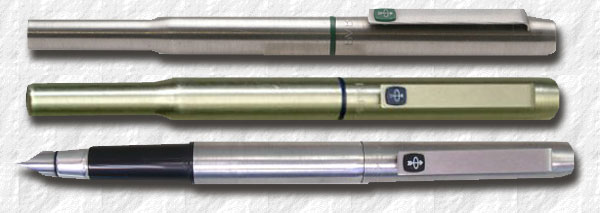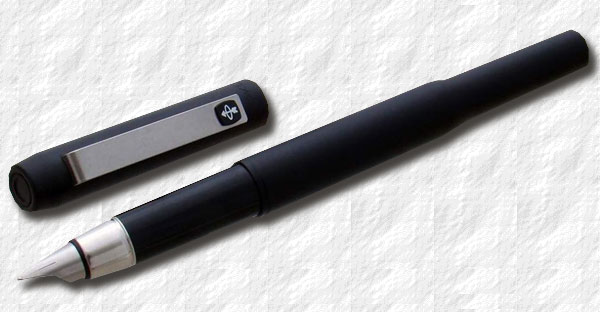
| parkerpens.net |
| PARKERCOLLECTOR.COM |
 1975—1994 |
||
In the early 1970's the UK sales force in Newhaven identified a customer's age group that previously had never been targeted by Parker, 18—30. They decided that they wanted a pen that would appeal to that age group, which potentially held 10 million customers.
|
The nib was also in steel but in spite of the low price it was sturdy and proved to be a surprisingly good writer. It was like the Volvo of the time— boxy but safe! |
|
 |
A selection of Flighter Parker "25", 1980's. |
|
In 1981 a Rollerball was introduced. There are several variations of the flighter Parker 25. The most significant is the colour of the plastic trim. The most common are the Black and Blue versions, the Blue being the most common, since it was produced for the whole duration of the model. The Black was made from 1975 until 1994. There are also two rarer colours, Orange (made 1975-1976 only, because of infringement claims from Rotring) and Green. The first MKI Patker 25's had a breather hole in the nib and a flat clip screw, the MKII was missing the hole, MKIII had a "dimpled" clip screw. MKIV was imprinted "Made in UK", as opposed to the earlier versions "Made in England". Date codes were introduced in 1980. |
In the long run it was clear that the Flighter model attracted the most customers so in early 1983 the Matte black was discontinued. As before mentioned times was not really good for pen manufacturers and hadn't been for decades. Parker was losing money. So when The Parker family was made an offer of $400 million from the subsidairy in Newhaven they decided that it was time to pursue other values in life. Hence Parker Newhaven in 1987 took over the Parker mother company. Again it was to be the Duofold that was to boost sales. To commemorate Parker's 100 anniversary the Centennial was introduced and in one year the new Parker company was again making money.
Nevertheless the Parker "25" still attracts users the world over. Even though it was produced for a very long time they still catch somewhat silly prices at auction sites. Without hesitation collectors pay six times the original selling price for a low-end all-steel pen that is quite common. The black one is even more sought for as well as the uncatalogued White Parker "25"'s, made between 1984 and 1987. Well, I suppose that says something about the quality. I use one myself as an everyday writer and it has never let me down. |
 |
A Matte Black Parker "25", 1980's. |
|
A White Parker "25", 1980's. Special thanks to Paul Barrell |
© 1995-2014 Tony Fischier and The Parker Pen Company®/Sanford Ecriture.
This page is in no way sponsored by or created by the Parker Pen Company®. All opinions, views, and thoughts expressed herein are expressly the authors, and in no way reflect the opinions, views, or thoughts of the Parker Pen Company®/Sanford Ecriture. All logos and/or images on these pages are © Copyright of Parker Pen Company®Sanford Ecritureunless otherwise stated and is reprinted by kind permission. If You feel that Your copyright has been violated please contact the WEBMASTER.
Everything on this website is copyrighted by law and can not be used without written permission from the author, Tony Fischier. You may however use the information as reference material and although it is forbidden to make digital copies or reproductions it may be physically printed for personal use, which does not include use on other web pages or in advertising. You may however quote parts of the content of this website, digitally or physically, providing that the source and author is clearly stated, together with the copyright information. In the US referred to as Fair use. If you use any information on this site, a link is appreciated.
Feel free to donate a small sum through Paypal to help this site to stay online. Acknowledgements.
Parkercollector.com in translated versions


